Last updated on May 25, 2023
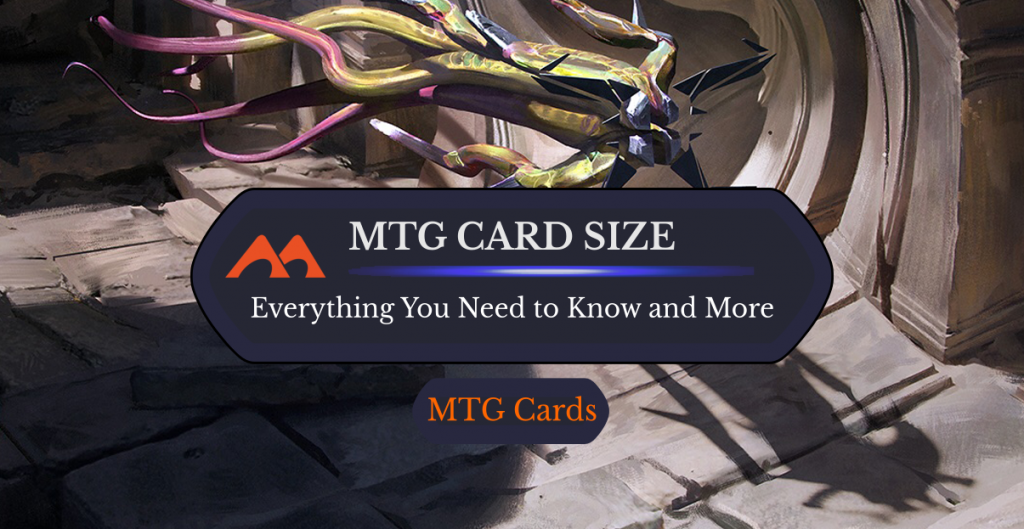
Dimensional Infiltrator | Illustration by Chase Stone
Let’s talk about size!
And obviously by that I mean the size of MTG cards. What’s the standard MTG card size? What about in pixels? Sleeves? Printing? Weight? Volume? Novelty items? There’s so much to talk about! I won’t keep you from this wondrous, exciting topic anymore. Let’s just get to it.
MTG Card Size: The Useful Stuff
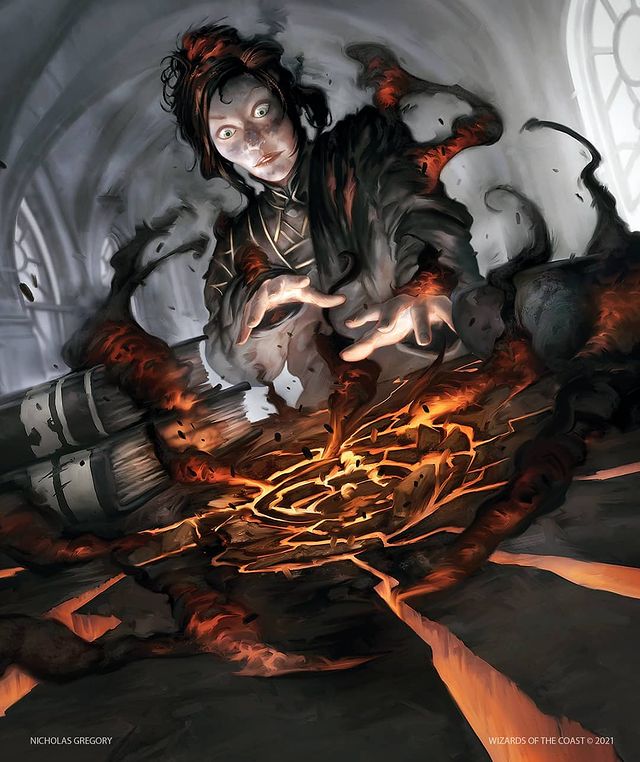
Introduction to Annihilation | Illustration by Nicholas Gregory
There are actually quite a few different things that we can talk about when it comes to the size of MTG cards, so we’ll start with some of the basic and useful info. Hold on to your hats, folks, ‘cause we’re about to dive into Magic card dimensions!
The Basics: Dimensions, Thickness, Pixels
First things first: what size are paper Magic cards? Don’t worry, we’ll talk about Magic card size in pixels for all of you digital players right after this. For now, we’ll look at what the MTG card size in inches is, and what the MTG card size is in mm.
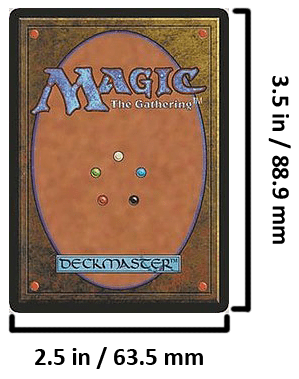
Tournament-legal cards have a width x height measurement of 2.5”x3.5”, or 63.5×88.9mm. When it comes to the thickness, non-foil cards are about 0.012”, or 0.305mm, thick. Foil cards, on their end, are a bit thicker as they have an extra layer on top of the card that creates that shiny, holographic look. When it comes to the corners of Magic cards, they’re rounded at a radius of about 0.125”, or 3mm.
However, according to our writer Jeff, who manages an inventory of over 1 million cards for Card Kingdom, these numbers can vary according to due to printing errors and the printing origin. Quality control for card stock and printing has been an issue for years, so do not expect exact consistency from card-to-card.
Fun fact: MTG cards are made using two pieces of card stock glued together with an opaque adhesive, just like regular playing cards. Except for rule inserts and tokens, which are made of a different card stock and don’t use the opaque glue that regular MTG cards do. Here’s a side view of a regular, non-foil Magic card, just for fun:
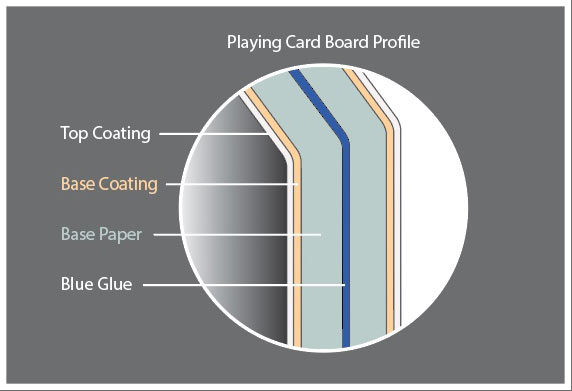
When it comes to the size of digital MTG cards in pixels, it can vary. Pixels aren’t a fixed width, just the smallest unit on any given screen. Digital images—like MTG cards on MTG Online or MTG Arena—are measured in pixels per inch (ppi), while the printing resolution of those images (i.e., how printed images are measured) is measured in dots per inch (dpi). The higher the dpi, the bigger the image will be in pixels.
Let’s make some assumptions, then. When printing high resolution images let’s say through Word, 300 and 600 dpi are the two recommended options, so we’ll look at those. To get the size in pixels, you multiply the size in inches by the dpi. For 300 dpi, 2.5*300=750 and 3.5*300=1050, so the card would be 750×1050 pixels. If we’re looking at 600 dpi, 2.5*600=1500 and 3.5*600=2100, so 1500×2100 is the size of the card in pixels. And that’s that!
If you want to go for a different dpi, you can now easily figure out what size the card should be in pixels on your own. Yay!
More Useful Details: Art Box, Text Box, Borders
Now let’s look at some of the components that make up the card itself. The art box, borders, and text box! Before we jump into that, though, how do MTG cards compare to regular playing cards? Well, we mentioned already that they have a similar construction. For size, they’re spot on when compared to “regular” playing cards (also called “poker size playing cards”) at 2.5”x3.5”. Now, on to more measurements!

Originally, the art box measured 2.1”x1.8”, but the border size was decreased in Magic 2015 to allow for a slightly bigger picture. This brought the art box measurements up to approximately 2.3”x1.8”, or 59x45mm. The text box for its part measures about 2.3”x1.28”, or 59×32.5 mm.
The border has a couple of different measurements around the card, so buckle up. First, we’ll talk about the border that we know and love today, first introduced in Magic 2015. The black border on the top and sides of the card is about 2mm. On the bottom, the black border thickens to about 6mm.
On the tops and sides of cards, though, there’s a second, colored border. On the top and left side, this colored border is about 1mm thick, while the right side is about 2mm thick. This ups the total border size on the top and left side to 3mm and the right side to 4mm, not accounting for the slight pop-out of the text bars that show the card’s name, type, and set symbol.
As we mentioned, MTG had a bit of a shake up when they changed the border size back in July of 2014. I broke out some of my oldest cards to see what these borders used to look like: Harbor Guardian from October 1996’s Mirage, and Vodalian Zombie from Invasion, released in October 2000.
Quick note: the borders were redesigned slightly in July 2003 with the release of Core Set 8th Edition. Older cards had the colored border encompass the card’s title, type, and set symbol areas, while the newer redesigned cards added boxes around these and slightly narrowed the colored borders. We’ll only be measuring the older design, since the Eighth Edition border is like a Frankenstein monster mishmash of the older and newest design. Take a look:
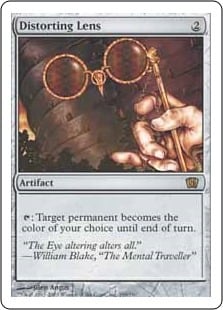
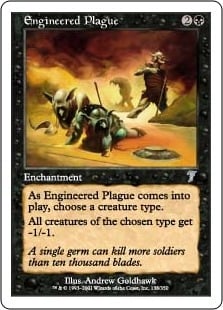
Just looking at the older cards, I can see the difference in the border size when compared to newer ones. The first thing to note is that the colored border continues on the bottom of the cards, whereas newer cards only have this colored border on the top and sides. But let’s take a look at the measurements, shall we?
First, the black border: this is uniform around the entire card, about 3mm. The top colored border is 5mm, while the sides are 4mm. The bottom of this border is 6.5mm thick. So, in total, the top border up to the art box is 8mm, the sides are 7mm, while the bottom up to the text box is 9.5mm. On these older cards, the text box is 2.1”x1.22”, or 54x31mm.
And… that’s about it! I’ve run out of (normal…ish) things to measure. Next, we’ll have a gander at what size you need to look at for card sleeves.
All About Sleeves
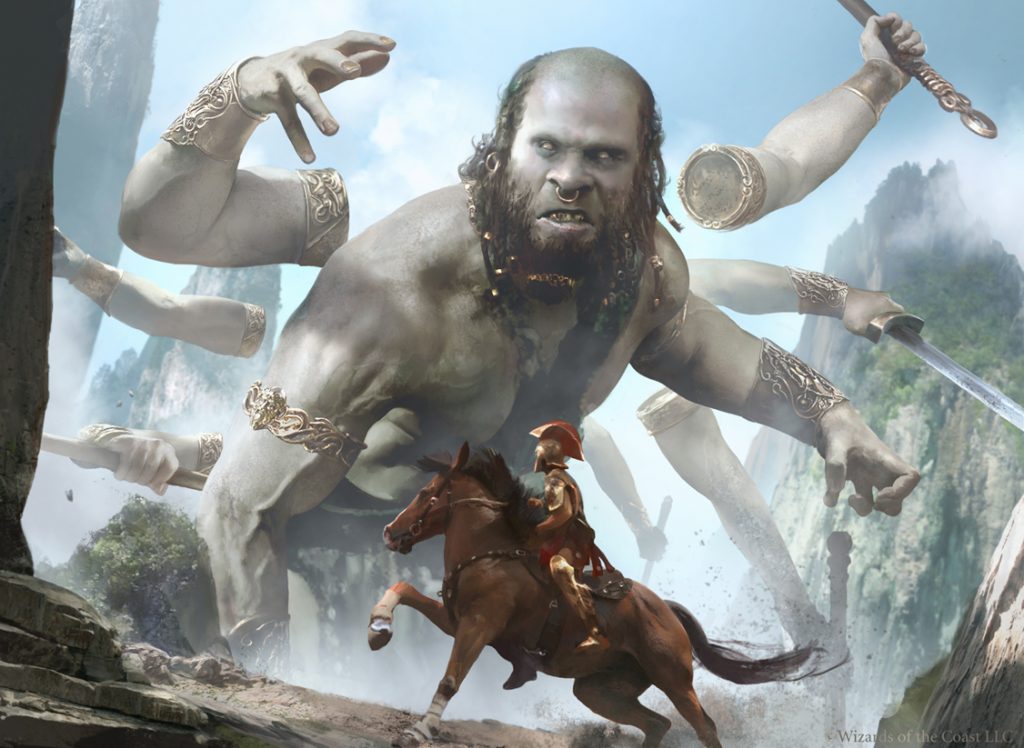
Hundred-Handed One | Illustration by Brad Rigney
When it comes to protecting and storing your cards, you probably need to get some card sleeves. Before we look at sizes and brands, though, the first thing to consider is what exactly you’re looking for.
If you’re just looking for a basic sleeve to protect your cards while playing, “standard size” sleeves are what you need. These are usually around 66x91mm. If, on the other hand, you want some sleeves for storing in a binder, what you need are “perfect fit” sleeves. These are designed to pretty much hug your cards like a second skin and will be smaller than standard size sleeves at around 64x89mm, just a touch bigger than the card itself.
On the third hand, if you’re looking to double sleeve your cards for extra protection, you’ll need both the perfect fit and the standard fit sleeves, one in the other. Now that we’ve got the basics out of the way, let’s look at some of the most popular brands and their sizes.
Arguably the most popular deck sleeve that you’ll see are the Ultra Pro brand. If you need a perfect fit sleeve, however, you may want to steer clear of their “Pro-Fit” sleeves as some players have had these bend their cards because they were so tight. You can get 10 packs of KMC’s perfect fit sleeves for a very reasonable price off Amazon—plus you get a slight discount if you order more—so these are a good choice if you want the most bang for your buck. The last brand to mention is Dragon Shield, which are a tiny bit thinner than other sleeves so they may save you some space and their perfect fit sleeves are sealable which is pretty cool.

If you’re looking at other brands, just follow the sizes mentioned above (standard: 66x91mm or perfect fit: 64x89mm) and you should be good. Pokémon cards are the same size as MTG cards, so sleeves for Pokémon cards will work as well and if you already have some you can use them for Magic cards too. Yu-Gi-Oh! cards, on the other hand, are smaller than MTG cards at around 60x85mm and use sleeves labelled as “mini” or “small”, so make sure not to pick those up.
Again, if you're trying to find out which sleeves you need for your cards, our guide/review is the place to go next.
Printing and Proxies
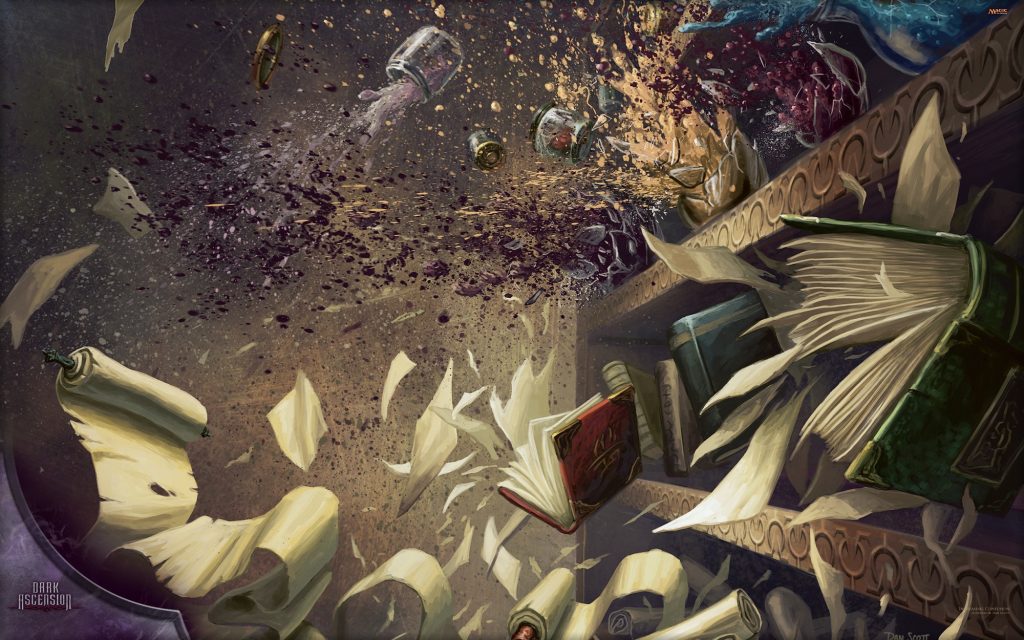
Increasing Confusion | Illustration by Dan Scott
What about if you just want to print out what’s known as “proxy” cards? Well, we’ve got you covered for that, too! Before we get to that, though, there’s a few things to mention.
Quick disclaimer: there is a huge difference between proxy cards and counterfeit cards. Proxy cards should not be made to be indistinguishable from their MTG card counterparts, and if they are, you’re getting into counterfeit territory and that is a slippery slope. For what should be obvious legal reasons, you can’t create MTG cards to sell or distribute since WotC own all rights to the card’s artwork, either though first printing rights or full purchased rights (I think the former is the case). Even printing MTG look-a-like cards just for personal use is skirting the line; most printing services will refuse to print these since it’s copyrighted material and illegal to print without permission, so be cautious.
This has been our disclaimer, thank you for your time.
If you’re super confused at this point because you have no idea what proxies are, let me explain: proxy cards are essentially printed, homemade copies of MTG cards with different art or abilities (sometimes), or a completely custom card that doesn’t exist in Magic like this or this. The former are typically made when players don’t own a card that’s not feasible to get, like Black Lotus — or any Power 9 card for that matter — or for more “authentic” playtesting.
Before we talk about printing and sizes, there is another kind of proxy card to mention. At DCI-sanctioned events, judges will sometimes print out proxies when cards are accidentally damaged during play, like if water was spilled on the table or someone was shuffling a bit too aggressively. It should also be noted that homemade proxy cards are banned from these events.
OK, now that all of that is out of the way, let’s get to the part that you probably actually care about: printing your own proxy cards! When it comes to MTG card size for printing, there’s a couple of things to keep in mind.
We already covered the size of Magic cards and the dimensions of their components, so that’s a start. Just so that you don’t have to keep scrolling all over the place, though, here’s a quick rundown of normal MTG card sizes that you should know for proxy printing:
| Inches | Millimeters | Pixels (300dpi) | Pixels (600dpi) | |
| Card | 2.5”x3.5” | 63.5×88.9mm | 750×1050 pixels | 1500×2100 pixels |
| Art box | 2.3”x1.8” | 59x45mm | 690×540 pixels | 1380×1080 pixels |
| Text box | 2.3”x1.28” | 59×32.5mm | 690×384 pixels | 1380×768 pixels |
Reminder: if you want to use a different dpi (or want to print a bigger card), just multiply the width/height of the card/art box/text box in inches by your dpi to find the width/height in pixels!
If you’re looking to print normal-sized proxies, you can use your printer at home to print out the proxy cards on a sheet of paper. If you don’t have a printer or need to print something bigger, you can go to your local Staples, Costco, etc. as long as you’re using custom artwork. You can slide the printed cards into a sleeve in front of a basic land ready for play or storage once they’re printed and cut!
Some good sites to get ready-to-print PDFs with MTG look-a-like proxies are MTGpress and Deckrealm. For an MTG card size template that you can use yourself to create completely custom cards, MagicCube has got your covered. There’s also MTGcardsmith to help you create the custom cards.
MTG Card Size: The Fun Stuff
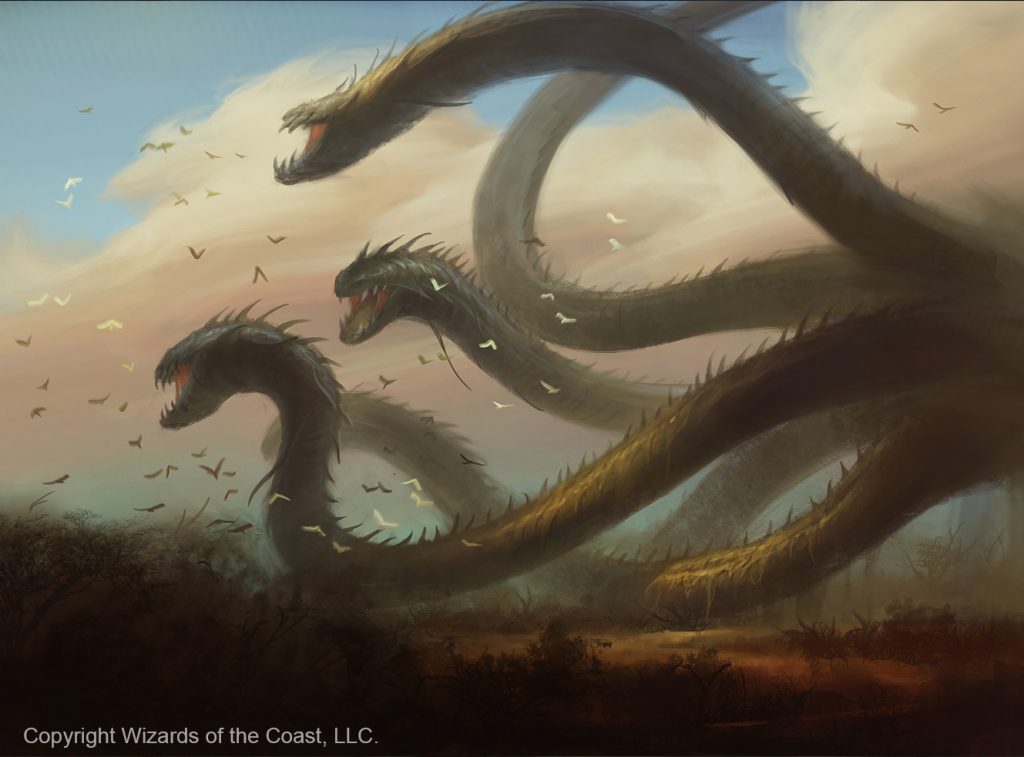
Multi-Headed | Illustration by YW Tang
We’ve covered basic and detailed MTG card dimensions, sleeve sizes, and proxy printing. What more could there possibly be to talk about when it comes to Magic cards? Well, the fun stuff that you don’t really need to know but the curious side of you wants to know.
What’s the volume and weight of a card, and what kind of crazy stuff have people done with them? What about awesome novelty cards from tournaments and events? We’ve got you covered!
The Stuff You Didn’t Know You Wanted to Know
Let’s start with the basic facts, and then we’ll get to the wacky stuff. The average MTG card weighs about 0.064 ounces, or 1.814 grams. But what about its volume, I hear absolutely no one ask? I’m so glad you mentioned it!
To calculate a rectangular cube’s volume—which is what we’ll consider a Magic card for the purposes of today’s experiment—you multiply length by width by height (in any order). An MTG card’s length is 2.5”, its width (i.e., thickness) is 0.012”, and its height is 3.5”. This makes the calculation to find its volume 2.5*0.012*3.5, which equals 0.105. So, a Magic card’s volume is 0.105 cubic inches. Ground-breaking stuff going on in this article today, I tell you.
What about some crazy experiments or weird stuff people have done with Magic cards? Well here’s what pops up when you google “MTG card dress”, so that’s fun! Want to watch someone boil a foil card (for science, of course)? Here you go:
If you haven’t heard of Because Science, let me introduce you to this wonderful channel with this video on building a computer in MTG—I’ll let them explain:
Novelty Cards: Big, Bold, and Beautiful
Ah, novelty cards. They remind me of giant stuffed animals you get for winning carnival games at fairs, in the best way possible. Isn’t it fun to have a giant version of your favorite cards, possibly even bigger than you are? I sure think so!
To start, Grand Prix and MagicFest give away jumbo-sized cards as prizes. From what I could find, the Grand Prix cards are about 26”x36” foam boards and are available in different languages. On MagicFest’s side, check out this promo video from the Toronto event at the beginning of the year:
There’s also Vanguard character cards, which are oversized at about 3.5”x5” and are used in the format of the same name. These aren’t like regular MTG cards; instead, at the beginning of a Vanguard format game, each player chooses a character card and plays following that cards conditions. Vanguard cards were printed in four sets between 1998 and 1999. Vanguard avatars are also used in casual games in MTG: Online, and the 2019 Mystery Booster set featured Ral's Vanguard as a test card.
Lightning round: Plane cards are 3.5”x5” cards from the Planechase series that modify the battlefield and affect all players. The multiplayer game Archenemy pits each player against one other player and uses 3.5”x5” Scheme cards that are meant to even the playing field. Three 3.5”x5” cards were included in each deck in the Commander and Commander 2013 releases, and the oversized planeswalker card was included in each deck in the Commander 2014 release.
Phew, that was fast! Gimme a second to catch my breath before we wrap this all up.
Time to Wrap It Up
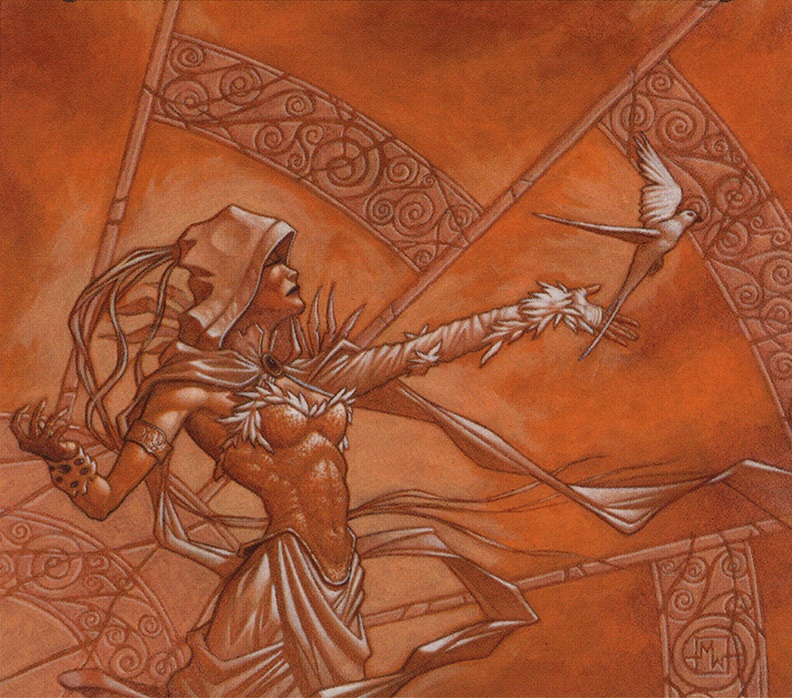
Serra | Illustration by Matthew D. Wilson
That’s about all I’ve got for you. I can’t think of anymore super important dimensions to drone on about for Magic cards. Hopefully this has been a journey for you as it has been for me, and I hope you’re still awake after all that math. It was very important, very exciting math! That the world needed the answer to!
All joke’s aside, did you learn anything interesting? Let us know in the comments below. Also can we please appreciate this absolutely beautiful list over at Forbes. I need more of that in my life, thanks.
Note: this post may contain affiliate links. If you use these links to make a purchase, you’ll help Draftsim continue to provide awesome free articles and apps.
Follow Draftsim for awesome articles and set updates:
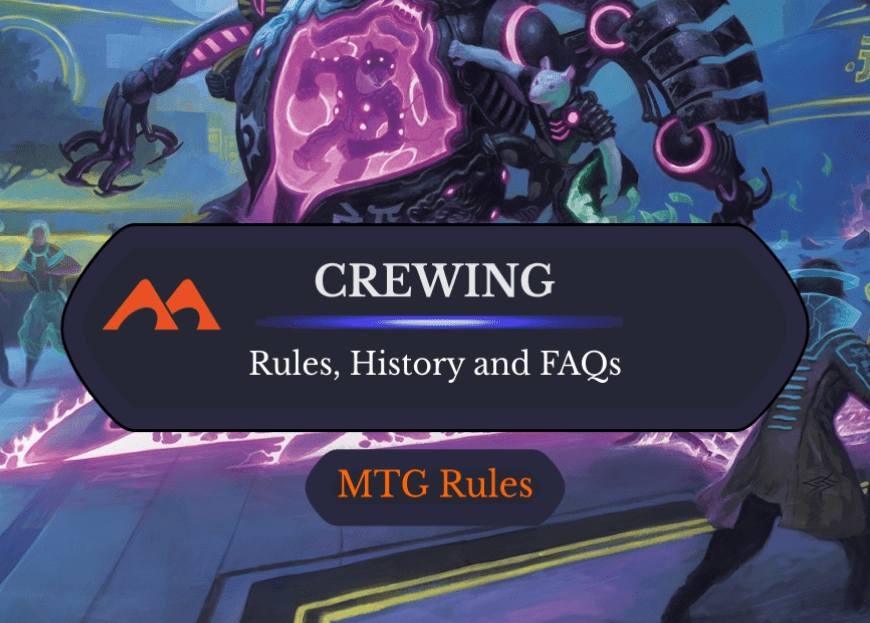
5 Comments
What would be the weight of the cardstock? i see 300 GSM/140lbs is that correct?
How many fit inside standard cardboard boxes is what I needed to know 😀
There are a lot of sizes and shapes of cardboard boxes! But you’re in luck, we have a whole discussion about storage for MTG cards here.
I checked and double-checked with a Caliper and cards are 63×87.9mm. Your measures are 0.5 & 1mm wrong, or WOTC changed their cards. Some application requires precision and the use of decimal on this site made me believe you were precise … anyways.
Hi – this is due to errors in product quality and consistency. We updated the article with an expert quote to explain further, thanks.
Add Comment